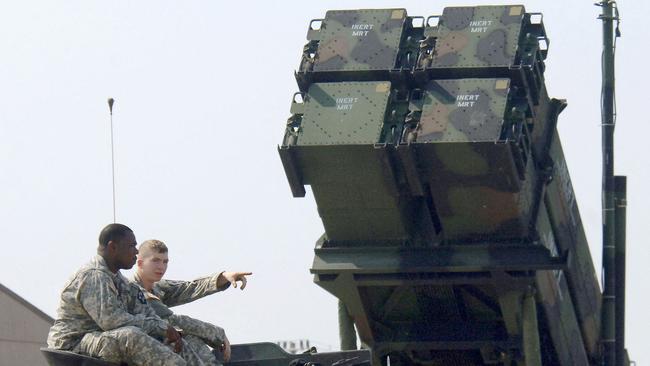We can’t go ballistic after missile defence systems left on the shelf
Labor’s new plan to rebuild the nation’s military has delayed the acquisition of tens of billions of dollars worth of new missile defence systems.

Labor’s new plan to rebuild the military has delayed the acquisition of tens of billions of dollars worth of new missile defence systems, putting off protection for Australian troops against the sort of attacks seen in Israel and Ukraine.
The government’s new investment program is silent on two major air defence programs listed in the 2020 version of the plan, worth a combined $23.1bn-$31bn.
The absence of the ballistic missile and medium-range air defence programs left industry figures scrambling on Thursday for more information on the fate of the investments.
Buried in the document was confirmation that decisions on the programs would be pushed back for at least two years.
“The acquisition of new active missile defence systems will be considered as technology matures, including in the context of the 2026 National Defence Strategy, taking into account developments in the technology used by the US and other key partners,” the plan said.
The systems have been on Defence’s wishlist for years to counter China’s rapidly growing arsenal of conventional missiles.
Beijing on Thursday protested that the Albanese government’s new defence strategy had identified China as a potential threat.
“China is committed to peaceful development and a national defence policy that is defensive in nature,” Chinese foreign ministry spokesman Lin Jian said.
Under the 2020 Defence investment plan, work was due to get under way on a $4.9bn-$7.3bn medium-range ground-based air defence system this year, which would have been in service by the early 2030s to protect deployed Australian Defence Force personnel.
Work was due to start on a $15.8bn-$23.7bn deployable ballistic missile defence system in 2025, and be well under way by 2034.
While neither of the programs is specifically referenced in the 2024 plan, the updated version includes $14-$18bn for missile defence across the decade.
The delay comes amid $72bn in program “reprioritastions” over the decade.
A Defence spokesperson declined to say whether the programs had been cut. “The 2024 Integrated Investment Program outlines a layered approach consisting of command and control, sensor, and both active and passive missile defence capabilities,” they said.
The delay to missile defence acquisitions comes despite the announcement last week by US President Joe Biden and Japanese Prime Minister Fumio Kishida of a new trilateral air defence network with Australia.

Defence Industry Minister Pat Conroy warned at the time that there was a long way to go before the nations could mount a co-ordinated response to a missile attack.
“People are getting very excited about Patriot missiles and other things,” Mr Conroy said, referring to the US-made anti-ballistic missile system.
“We’re not at that stage. The most important thing is to have the brains of the systems … being able to talk to each other. That’s the first step.”
Israel, the US, Britain and Jordan used a variety of air defence systems during Iran’s unprecedented strike on the Jewish state last Saturday, destroying 99 per cent of more than 300 incoming missiles and drones.
Ukraine, meanwhile, is pleading with its international partners for more missile defence systems to protect its troops, cities and critical infrastructure from relentless Russian attacks.
“This includes establishing the underpinning architecture to connect active missile defence systems and provides the foundation for further capabilities to be added over time,” Kyiv has said.
Promoting the government’s new defence plan on Thursday, Mr Conroy revealed the in-development Ghost Shark underwater drone was now the government’s highest priority Defence technology program.
Designating the program as “Mission Zero” for the government’s new strategic capabilities accelerator, he said the autonomous submarine was being developed for reconnaissance and strike roles, and the technology could be shared under the AUKUS pact.
“Ghost Shark is an exemplar of how Defence and Australian industry can move at speed to develop new sovereign capabilities to respond to the challenges before us,” Mr Conroy said.
A day after Richard Marles attacked the Coalition’s resolve on defence, opposition foreign affairs spokesman Simon Birmingham confirmed the Coalition would match and exceed the government’s plan.
“We have been discussing consistently the imperative for Australia to invest, and invest more in our national security and national defence,” Senator Birmingham said. “We have been appalled and alarmed by the extent to which the Albanese government has cut defence projects and investment since they came to office.”








To join the conversation, please log in. Don't have an account? Register
Join the conversation, you are commenting as Logout